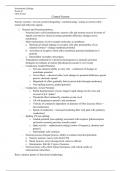Lecture notes
Control Systems of Invertebrates
- Institution
- University Of Reading (UoR)
Neurons and Neurotransmitters, Functional morphology, Organisation of Nervous System, Brain Power, Receptors and Sensory Processing, Sensory Processsing
[Show more]



